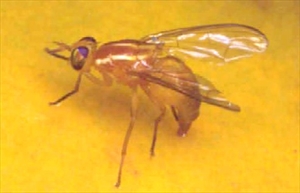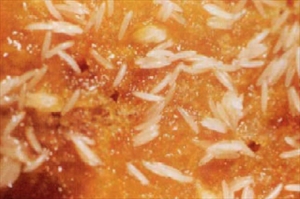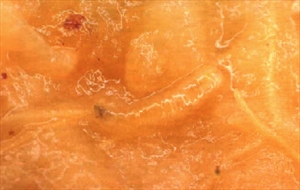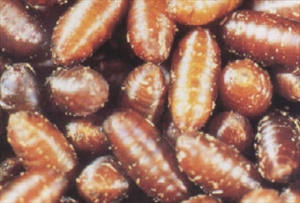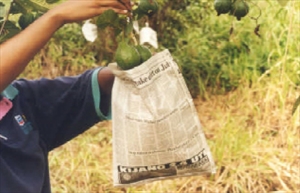There are six fruit flies in Tonga. The species of economic importance are: (i) Bactrocera facialis (except the Niuas); (ii) Pacific fruit fly (Bactrocera xanthodes), (iii) Bactrocera kirki; (iv) Bactrocera species near passiflorae (Niuas only); and (v) Bactrocera distincta.
Pacific Pests, Pathogens, Weeds & Pesticides - Online edition
Pacific Pests, Pathogens, Weeds & Pesticides
Tonga fruit flies (171)
Bactrocera facialis, Bactrocera kirki, Bactrocera xanthodes, Bactrocera passiflorae, Bactrocera distincta, and Bactrocera obscura. Bactrocera xanthodes is closely related to three other species. These are: Bactrocera paraxanthodea in New Caledonia, and Bactrocera neoxanthodes in Vanuatu, and a species not yet described from Samoa
The SPC Pacific Fruit Fly Project records 6 species in Tonga (http://www.spc.int/lrd/country-profiles/tonga).
The distribution of the Tonga fruit flies elsewhere in the Pacific island region:
Bactrocera kirki: American Samoa, Fiji (Rotuma), French Polynesia, Niue, Samoa, and Wallis and Futuna.
Bactrocera facialis: It occurs in Tonga only, except for the northern Niuas islands.
Bactrocera xanthodes (Pacific fruit fly): American Samoa, Cook Islands, Fiji, French Polynesia (Austral Islands), Niue, Samoa, Tuvalu, Vanuatu, and Wallis and Futuna.
Bactrocera species near passiflorae: Tonga (Niuas islands), Fiji (but not Rotuma), Tuvalu and Tokelau.
Bactrocera distincta: American Samoa, Fiji, Futuna, and Samoa.
Bactrocera obscura: Tonga (no other information).
The hosts of the species of economic importance are:
Bactrocera kirki infests: avocado, mango, Tahitian chestnut (Inocarpus fagifer), Indian or tropical almond (Terminalia catappa), Surinam cherry, guava, mandarin, orange, passionfruit (Passiflora edulis), soursop, star apple (Averrhoa carambola) Malay apple (Syzygium malaccense) and rose apple (Syzygium jambos).
Bactrocera facialis infests: 64 species of fruit and vegetables on 48 plant genera covering 29 plant families. The major hosts of economic importance are: avocado, chillies, citrus (orange, sour orange, pomelo, mandarin, grapefruit, kumquat), guava, mango, Malay apple (Syzygium malaccense), Tahitian chestnut (Inocarpus fagifer), tomato, and Indian or tropical almond (Terminalia catappa). It has also been bred from breadfruit, cashew, papaya, passionfruits (Passiflora foetida, Passiflora ligularis, Passiflora quadrangularis), sapodilla (Manilkara zapota), soursop, star apple (Chrysophyllum cainito), and Surinam cherry (Eugenia uniflora).
Bactrocera xanthodes infests: avocado, breadfruit, granadilla (Passiflora quadrangularis), mandarin, mango, papaya, passionfruit (Passiflora edulis, Passiflora ligularis), and tomato.
Bactrocera species near passiflorae infests: avocado, giant granadilla, guava, mandarin, papaya, sweet orange, Tahitian chestnut, tropical almond, Calophyllum inophyllum, Hernandia nymphaefolia, Guettarda speciosa and Ochrosia oppositifolia. Its economic impact has not been assessed.
Bactrocera kirki is black with yellow markings near the head and wings (Photo 1). The abdomen is glossy black with orange-brown bands in the middle, from top to bottom. Mating occurs late morning or early afternoon.
Bactrocera facialis is native to Tonga. It is slightly smaller than a housefly with a black thorax (the part below the head), yellow areas near the wings, and on the triangular area at the end of the thorax. The abdomen or lower body is orange-brown except for some black markings in the middle and towards the sides. The wings are mostly clear, except for dark veins on the front of the wings (Photo 2).
Bactrocera xanthodes is a little larger than a house fly. It is brown-orange with three yellow stripes on the upper surface of the middle part, the thorax (Photos 3&4). This fruit fly is found in villages, towns and coastal areas, but not forests. Mating occurs at dusk.
Bactrocera new species is similar to Bactrocera passiflorae, except that the abdomen has many pale markings. (See Fact Sheet no. 170 for a description of Bactrocera passiflorae.)
Adult flies pierce the fruits with their ovipositors to lay eggs under the skin (Photos 4&5). As the eggs are laid, bacteria are also inserted into the fruit; these rot the fruit and provide the larvae or maggots (Photo 6) with the food that they need.
The eggs hatch in about 2 days, and fruits start to rot after about 3 days. At 5 to 7 days after egg laying rots are obvious. When completely rotted, the fruits fall to the ground, the maggots enter the soil and pupate (Photo 7) until the adults emerge. Emergence is 18 to 20 days after the eggs were laid.
Fruit flies find the fruits to lay in by their colour, shape and the smell of the fruit, leaves and the bacteria on them.
The fruit flies feed on the juices from fruit, nectar from flowers, honeydew from insects, bird faeces and bacteria. Young females need protein foods before they become sexually mature and able to lay viable eggs.
Bactrocera facialis is an extremely damaging fruit fly. It destroys 97-100% of capsicum and 89-97% of chilli. Bactrocera facialis and Bactrocera kirki are collectively responsible for 90% of the infestation on guava.
All three species (Bactrocera facialis, Bactrocera kirki, and Bactrocera xanthodes) are of economic importance, laying eggs in a wide range of fruits which subsequently develop bacterial rots upon which the larvae or maggots feed. The rotting causes the fruits to fall.
Look for a black fly with yellow markings on each side of the thorax closest to the head and wings, and orange-brown longitudinal bands in the middle of the abdomen (Bactrocera kirki); a fly with a black thorax with yellow markings on each side of the thorax near the wings, a triangular area at the rear of the thorax, clear wings, except for dark veins on the front of the wings, and a mostly orange-brown abdomen (Bactrocera facialis); and a slender, almost translucent, light brown-orange fly with three yellow stripes (Bactrocera xanthodes). Male Bactrocera xanthodes are attracted to methyl eugenol. Cue-lure attracts the males of Bactrocera facialis, Bactrocera kirki and Bactrocera disticta. Males of the undescribed species - the light coloured form of Bactrocera passiflorae - are also attracted to Cue-lure.
QUARANTINE
There is need for vigilance and public awareness programs to prevent the entry of exotic fruits fly species. Routinely, pairs of traps, one with Cue-lure, the other with methyl eugenol, should be placed in backyard gardens in villages and towns, rubbish dumps, hotels, resorts, research stations, airports and seaports, and checked weekly. Host fruit collections should also be made to confirm the species present, their distribution, seasonal abundance, and the impact and incidence of parasitoids.
NATURAL ENEMIES
In general, predators (spiders, ants, assassin bugs and carabid beetles) have had little effect on populations of fruit flies. Parasitoids, too, have only been found at low levels in Pacific island countries, and introducing others is probably not worthwhile.
CULTURAL CONTROL
An integrated approach to fruit fly management is needed which combines bagging of fruit, fruit production during times of low fruit fly populations, the use of less susceptible varieties, hygiene measures, and protein bait sprays.
Before planting:
- Consider growing crops in the cooler months when fruit fly populations are at their lowest. For instance, during the cooler months of May to August the damage caused to capsicums in Tonga falls to about 10%.
During growth:
- Bag the fruit with double layers of newspaper or use brown paper bags. On three sides, fold over the edge of the newspaper for 2 cm, and staple the folds in place (Photos 8). Place the fruit in the bags as shown. This is a suitable method for protecting starfruit (Averrhoa carambola), mangoes and also snake gourd (Trichosanthes cucumerina).
- Alternately, use leaves of coconut, Pandanus, betel nut, sago palm instead of paper to cover the fruit. Cover fruits of banana with leaves (Photo 9) to protect against banana fruit fly, birds, and also to improve appearance.
- Collect fallen and overripe fruit, and destroy by burning, burying or putting them in a plastic bag left in the sun for a day. Control by sanitation is best if it is done routinely by all growers over as wide an area as possible.
- Harvest early before the fruit is susceptible to fruit fly attack. This method is used for bananas and papaya. Bananas are harvested green and papaya at colour break.
After harvest:
- Collect all discarded fruit and destroy them using the methods listed above.
RESISTANT VARIETIES
Some fruit varieties have been tested and found to be 'non-hosts' for fruit flies. For instance, the chilli varieties 'Hot Rod' and 'Red Fire' in Fiji. Also, pineapples are non-hosts for fruit flies in Fiji at any stage. Other crops that may be non-hosts or low risk are squash, pumpkin, zucchini, cucumber, and some varieties of watermelon, rockmelon, limes and papaya at colour break. Check with the agriculture authorities for the latest tests that have been done, and lists of appropriate varieties.
CHEMICAL CONTROL
Female fruit flies need protein for their eggs to mature properly. Protein bait sprays make use of this need by combining a protein source with an insecticide. In Pacific island countries, the protein is either a commercial autolysed yeast product (MPPIL, Mauri's Pinnacle Protein Insect Lure) - broken up yeast cells in which the proteins have been converted into simpler compounds using enzymes - or protein autolysate from brewery yeast waste. In Tonga, the product is known as Royal Tongalure.
If MPPIL is used, place 50 ml MPPIL concentrate and 4 ml malathion 50% emulsifiable concentrate into a bottle and make it up to 1 litre with water. If Royal Tongalure is used, replace the MPPL, with 100 ml of Royal Tongalure in the MPPIL recipe above.
The bait solutions are sprayed at a rate of 50 ml per m2 on each tree in the orchard, and on surrounding trees. On capsicum, chillies and cucurbits, 20-25 litres per hectare are applied as a spray to every third row.
A third product called Bactrogel has been developed; this is a powder containing fipronil. Add 50 g Bactrogel to 9.7 litres water, stir to dissolve, and add 300 ml protein bait concentrate, and again stir to dissolve. Much smaller amounts are needed compared to the other two. Apply 10 ml to lower surface of leaves on each tree. For vegetables, spray 5-10 ml at 4 m intervals along rows, and every 2-3 rows, depending on spacing. Small, hand-held sprayers can be used which deliver a coarse straight jet of liquid.
____________________
When using a pesticide, always wear protective clothing and follow the instructions on the product label, such as dosage, timing of application, and pre-harvest interval. Recommendations will vary with the crop and system of cultivation. Expert advice on the most appropriate pesticide to use should always be sought from local agricultural authorities.
AUTHOR Grahame Jackson
Information (and photos) Fruit flies in Tonga (2001), SPC Pest Advisory Leaflet 41 (https://lrd.spc.int/pest-advisory-leaflet); and from Fruit fly control methods for Pacific island countries and territories (2001), SPC Pest Advisory Leaflet 40. (https://lrd.spc.int/pubs/cat_view/469-pest-advisory-leaflets).
Produced with support from the Australian Centre for International Agricultural Research under project PC/2010/090: Strengthening integrated crop management research in the Pacific Islands in support of sustainable intensification of high-value crop production, implemented by the University of Queensland and the Secretariat of the Pacific Community.



